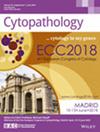Application of the International System for Serous Fluid Cytopathology in Cerebrospinal Fluid Cytology
Abstract
Objective
To evaluate the application of The International System for Serous Fluid Cytopathology (TIS) in cytology cases of cerebrospinal fluid (CSF).
Methods
A retrospective analysis was conducted on 618 CSF samples from two hospitals in Athens, Greece, over a 5-year period. CSF samples were processed with conventional cytological techniques or liquid-based preparations, stained with Giemsa and Papanicolaou staining. Immunocytochemistry was used when necessary. Samples were classified by two cytopathologists into the five TIS categories: nondiagnostic (ND), negative for malignancy (NFM), atypia of undetermined significance (AUS), suspicious for malignancy (SFM) and malignant (MAL).
Results
Of the 618 CSF samples, 78.8% were classified as NFM, 19.4% as MAL and 1.3% as ND. Only 0.5% of cases were categorised as AUS, and no cases were classified as SFM. In patients with a history of neoplasia and suspected CSF involvement, the malignancy detection rate was 38%, while it was only 5.6% in patients with neurological symptoms but no known neoplasia. The most common metastatic cancers in the CSF were breast carcinoma, lung adenocarcinoma and lymphomas.
Conclusions
The classification of CSF cytology samples using TIS proved to be feasible and effective. Notably, the majority of samples fell into the NFM and MAL categories, while the AUS and ND categories were rare. These findings suggest that this classification could provide a reliable framework for CSF cytology reporting, improving diagnostic accuracy and potentially aiding in clinical decision-making.
Two-Liner: This study offers proof of the value of the application of The International System for Serous Fluid Cytopathology in the cytological interpretation of cases of cerebrospinal fluid.


 求助内容:
求助内容: 应助结果提醒方式:
应助结果提醒方式:


